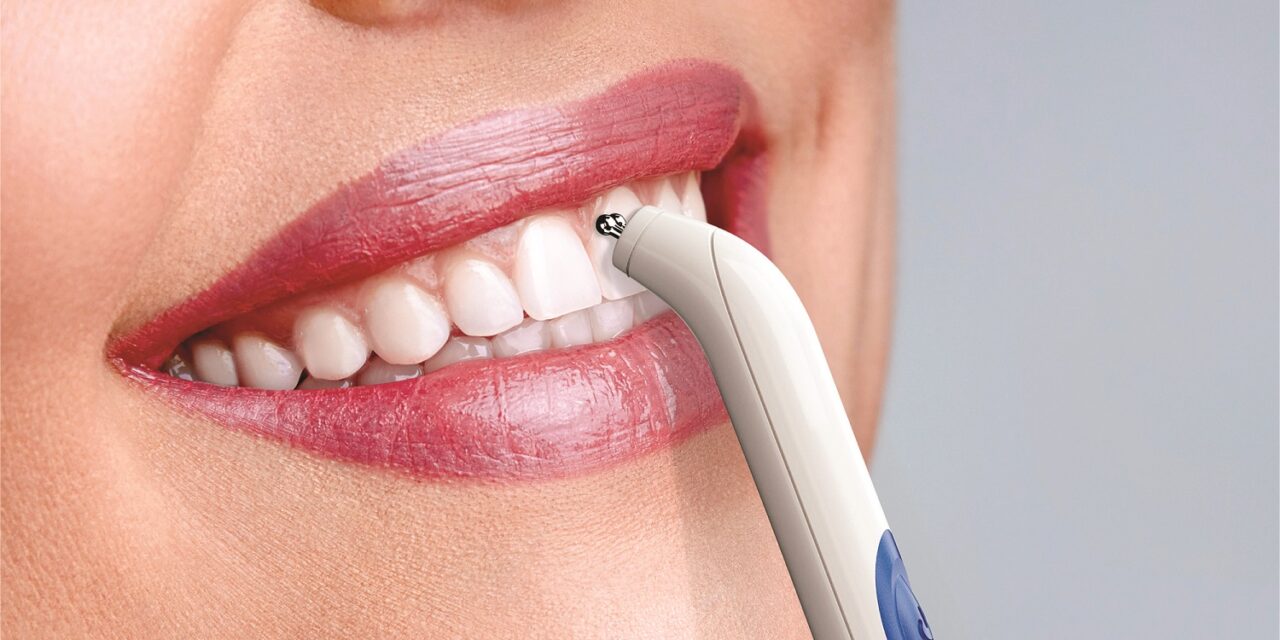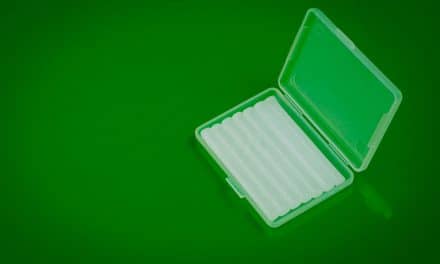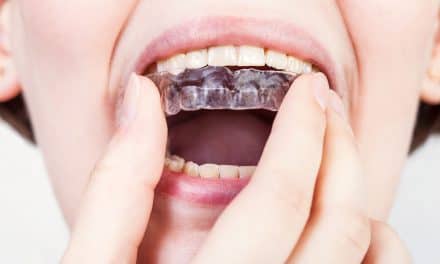Orthodontic Products spoke to the inventor of the Dental Pain Eraser, a portable electronic device that can provide oral pain relief.
The American Association of Orthodontists (AAO) named Cosmo Haralambidis, DMD, co-founder of Synapse Dental, the winner of the 2023 AAO Ortho Innovator Award, for the Dental Pain Eraser.
The electronic dental anesthesia device uses patented technology to provide oral pain relief. The device can be used both in-office and as a take-home device to help patients in orthodontic treatment manage their pain at home. What’s more, the Dental Pain Eraser can work as a marketing tool with referring dental colleagues.
Haramlambidis, a board-certified orthodontist practicing in Cranston, Rhode Island, has been at the forefront of orthodontic innovation for over a decade. To find out more about the Class II FDA-cleared medical device, Orthodontic Products spoke to him.
Orthodontic Products: How does the Dental Pain Eraser work and what inspired you to create it?
Cosmo Haralambidis, DMD: The Dental Pain Eraser is the world’s first pen-shaped, portable electronic dental anesthesia solution that uses patented Advanced PulseWave neuromodulation technology to send gentle, subsensory electric pulses to calm the nerves in the mouth and block both soft and hard tissue pain. When the Dental Pain Eraser’s metal probes are applied to a sensitive tooth or gums, the pain will begin disappearing in seconds, with pain relief lasting for up to 48 hours.
We know that millions of people avoid the dentist because they fear needles and pain. We also know that patients are prescribed pain medication, contributing to the opioid epidemic. As a practicing orthodontist, I recognized that our profession could do better, and started thinking about solutions at the intersection of medicine and dentistry such as electric pulses from neuromodulation that could help. After years of extensive research in neuromodulation, the Dental Pain Eraser was born.
OP: The Journal of Clinical Orthodontics published a peer-reviewed study in 2019. What were the key findings?
Haralambidis: The main objective was to show inhibition of pain from a single 20-second application of the Dental Pain Eraser neuromodulation PulseWave. Remarkably, the study found that a single dose of 20 seconds resulted in significant and immediate pain inhibition and that pain relief lasted for 48 hours. Typically, there would be a steady and significant increase in pain response from 2 hours to peak pain at 24 hours with a slow decline in pain 48 hours later in the placebo group. The pain response in the untreated and placebo patients mirrored data from many other pain studies.
The study revealed several other critical findings, including the Dental Pain Eraser’s ability to immediately block pain up to 1 cm depth from the probe contact point, working on both soft and hard tissue of the periodontal and oral complex. Inhibition of soft tissue, muscular, ligamental and dental tissue nerves not only affects sensory perception of pain, but also helps reduce the neuromodulatory response of inflammation, allowing for a control mechanism of inflammation and swelling. These findings have broader implications for the future of dental medicine.
The fact that the Dental Pain Eraser not only altered the neuroinflammatory response immediately, but sustained it for another 48 hours after a single 20-second application, shows that a local alteration of neuroinflammatory response causes surrounding neural cascade communications locally (adjacent neurons) and centrally (the central nervous system-CNS), and to vascular and immune cells. This offers broader clinical applications, and helps us understand why modifying application time can affect various forms of oral pain—including TMJ, phantom tooth pain, and post-orthognathic surgery pain.
OP: How do you envision orthodontists incorporating the Dental Pain Eraser?
Haralambidis: The Dental Pain Eraser is an excellent way to transform the patient experience and build relationships across your referral network, as well as increase revenue, new case starts, and referrals.
It comes in two models: One for office use and the other for use at home by the patient. The office device is an amazing solution for debonding sensitive patients, and the take-home for addressing oral pain in as fast as 15 seconds. Simply apply the Dental Pain Eraser to the gums or hard tissue and the relief will last from hours to days.
Whether used in office or at home, the Dental Pain Eraser reduces discomfort experienced from TMJ, anchor placement, osteoperforation, aphthous ulcers, abrasions from dental and complex lingual fixed appliances, mucositis, appliance pain, fixed bite correctors (Class II and other), aligner therapy, and general orthodontic discomfort. It makes pain more manageable and allows for better inflammation control.
OP: How is the Dental Pain Eraser a revenue maker and not a cost to the office?
Haralambidis: From data collected through various teledentistry/teleorthodontic platforms, we have discovered that with the Dental Pain Eraser we can help manage patient pain for both our orthodontic patients and those patients who have difficulty accessing care—and we are able to be reimbursed. COVID certainly proved the value of teledental platforms and validated quick and easy reimbursement mechanisms. Use of automatically-paid, simple codes, such as D9110 and others, has allowed 1.5 times and more return on each device given to the patient, making it a revenue maker, not a cost to the office.
OP: How often and how long do patients use the take-home device?
Haralambidis: The Dental Pain Eraser is super easy to use. Simply turn the device on, place the device’s metal tips on the gums or tooth, and move the tips (up and down or side-to-side) like painting a pole for the recommended amount of time. For example:
- For braces pain, the patient moves the tips on their gums for approximately 20-30 seconds per tooth.
- For mouth sores, the patient completes a full circle around the sore for approximately 30 seconds.
- For TMJ pain, the patient applies the device for a minimum of 4 minutes to the pain trigger area in the lateral and medial pterygoid muscle and insertion points.
- For general postoperative tooth pain or hyperocclusal orthodontic pain, a minimum of 2 minutes application on the buccal attached and mucosal tissue with an added 30 seconds on the tooth structure can provide significant pain relief.
Practitioners can quickly show the patient how to use the device in the office, and they can also give their patients one of our instructional cards (with a link to our instructional video) to review on their own.
The Dental Pain Eraser can be applied for as long as needed to relieve pain, anywhere from a few seconds up to 10 minutes. Pain relief can last up to 48 hours, and the Dental Pain Eraser can be reapplied as needed.
OP: What sets the Dental Pain Eraser apart from other pain relief options?
Haralambidis: The Dental Pain Eraser is the only oral pain relief solution that relieves pain within 30 seconds and lasts for up to 48 hours; is drug-free, needle-free and numb-free; is without side effects; and is safe for children and adults. In fact, children can utilize it at school, avoiding the need for the nurse’s permission to use oral pain medication.
Imagine instant oral pain relief and prevention with no shots, no pills, no gels—reducing needle phobia, reducing opioid Rx, and contraindications/allergies to medications.
Any member of your clinical team can initiate a simple protocol of a minimum of 2 minutes of application of the Dental Pain Eraser with a light massaging slow motion touch on the soft tissue buccal root surface while simultaneously educating the patient on how to self-apply. This allows a comprehensive, less invasive, and compassionate approach, pain relief, and an enhanced patient experience.
The Dental Pain Eraser has proven to affect the neuroinflammatory response and stands apart in the art of neuromodulation of not only pain, but inflammation. The concept of controlled electronic titratory response in our field has been born. This has opened the door to many new developments and uses across many indications that are in development today.
OP: Synapse Dental offers a practice-branded version. How can this be used as a marketing tool?
Haralambidis: With a practice-branded Dental Pain Eraser (for clinicians and patients), you can set yourself apart from your competition and build brand awareness. Your patients and your referral network will recognize that you’ve gone above and beyond to help manage a patient’s discomfort before, during, and after a visit. Your team will show patients not only how to relieve orthodontic and soft tissue pain, but how they can utilize the Dental Pain Eraser at their hygiene and dental appointments. Think of the reaction you will get when your patients tell the hygienists, “I am going to apply this for 1 minute in the area you are working to make me feel really comfortable”; or when your patient tells their dentist, “Can you apply this for 1 minute to the area that you will be giving the injection?” Your office will get the WOW! effect and enforce the message of how you are at the cutting edge of care for your patients.
OP: What does winning the award mean to you?
Haralambidis: Being recognized by my peers with the AAO Ortho Innovator award is an incredible honor for me. Creating the Dental Pain Eraser has truly been a labor of love. All these years, it’s been my personal mission to change the perception of dentistry by creating both a pain-free experience for our patients and giving birth to a new area of neuromodulation science for our field.
OP: Are there any upcoming updates planned for the device?
Haralambidis: We recently launched the Dental Pain Eraser’s new 4-prong tip option, which provides a larger area of PulseWave delivery for quicker use—such as muscular application along the intraoral TMJ muscle complex, larger oral sores, but most importantly pre-application with palatal injections. The 2- and 4-prong tips are also expanding usage for direct constant contact application during caries removal in pediatric and adult patients, reducing the need for local anesthesia and assisting patients who are needle phobic. And we have expanded the Dental Pain Eraser application. Previously it was validated for pre-needle use; but now its clinical effectiveness has been validated for broader hygiene appointment use.
Photo courtesy of Synapse Dental










